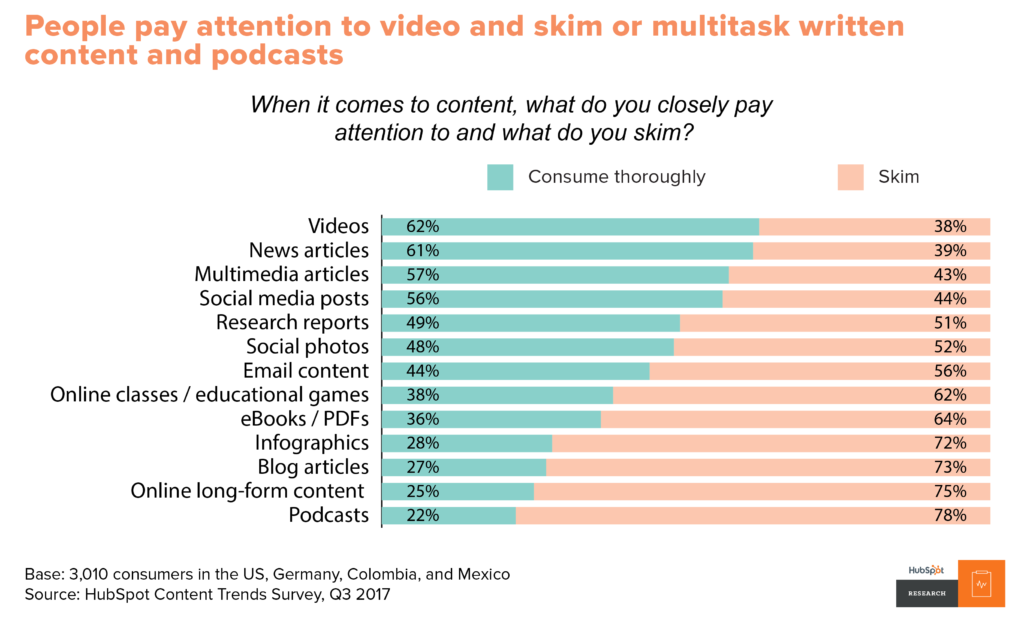POSTED : December 22, 2017
BY : Spencer Pereira
Categories: Experience Platforms

B2B marketing trends are constantly evolving. Today’s B2B marketer must work with a multitude of content channels and an elusive audience that prefers to interact over a screen. But, some clear trends are emerging in the digital space that can help guide our efforts in 2018.
Marketing needs to match your target audience’s context. This means designing content that speaks to your audience’s current problems and concerns.
Online advertising formats are cementing this strategy. Google ads work well when your content provides a meaningful response to users’ questions. Twitter enables advertisers to promote posts to users whose tweets include targeted keywords. Their goal is to present the ad when the topic is most relevant to an audience.
Tesla demonstrated the importance of this trend in their promotion of the Model 3, their first economy car. The campaign ran without the car—it still needed to be manufactured. Their messaging centered around clean energy, not the product. They were able to connect with their target audience’s concerns. As a result, they earned four times the number of sales of their closest competitor at a fraction of the advertising cost.
Instead of developing content around target personas, more companies are tailoring their messaging to target accounts. Account-based marketing, ABM, organizes marketing efforts around a single account. This could be a prospective client or a current customer. The strategy is typically used in B2B enterprise-level companies.
Within a single account, there are multiple stakeholders. Marketing teams that practice ABM develops content for each decision-maker’s role in the organization.
This strategy requires a strong alignment between Sales and Marketing. To find ideal accounts, Marketing must rely on colleagues in Sales for insights.
A recent HubSpot report revealed clear differences between the preferred content formats of younger and older audiences. In a survey of over 3,000 people, across different age groups, millennials showed a strong preference for social content while older generations showed a liking for more traditional formats: email, news articles, and research reports.
But, across all age groups, video is in high demand. Respondents not only indicated they want to see more video content in the future but also suggested it was the most likely format to hold their attention.

Many emerging brands have decided to put their social mission above their bottom line. In their marketing they tell stories, highlighting the purpose behind their products. This form of promotion allows the audience to feel like they can participate in the mission of the organization.
Cotopaxi, an emerging retailer of outdoor gear, based in Salt Lake City, Utah, has grown to compete with long-standing brands like Patagonia and L.L. Bean by taking a radically different approach to marketing and corporate social responsibility. They scrutinize each level of the supply chain, working to make their core business a force for good, not just their corporate donations.
In an interview with Forbes, Davis Smith, CEO, said, “Using your supply chain and the products you make to affect change rather than just your profits creates a culture that transforms how we look fundamentally at how we do business.”
To make messages relevant and timely, marketers are analyzing more data-points and distributing content across more platforms. Audiences engage with content on apps, social sites, blogs, YouTube channels, and industry publications.
It falls upon Marketing to meet target audiences where they are and at the right time. To accomplish this, teams are looking at tools like Segment and Hootsuite. In the 2016 State of Marketing Report, researchers at Salesforce reported “best in class marketing organizations use 14 tools on average.”
Marketing strategies for 2018 must place the audience at the center, not the product. People are responding to companies that speak to their concerns, whether that be deforestation or poorly-implemented software.
It can be difficult to intuit the concerns of your potential customers. You can turn to the sales team for insights based on their conversations with existing customers. Feedback surveys and frequently asked questions can also help get you started. Through that effort, you will gain a repository of meaningful topics that can fuel your content engine throughout 2018.
If you have more questions about Salesforce we’d love to connect. Please feel free to contact us so we can schedule a no-cost/no-commitment consultation with our team of certified Salesforce experts.
Spencer Pereira has a degree in integrated marketing communications and writing. He has worked in various marketing roles at Google and Valmont Industries.
Tags: B2B Marketing, Salesforce